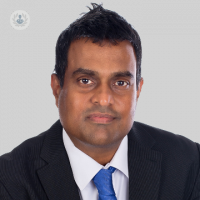Endometriosis and its treatment
Written in association with:Endometriosis is a chronic condition in which tissue similar to the lining inside the uterus, called the endometrium, starts to grow outside the uterus. This can cause pain, inflammation and the formation of scar tissue. Endometriosis most commonly affects the ovaries, fallopian tubes, and the tissue lining the pelvis, but it can also spread beyond the pelvic organs.
Leading laparoscopic surgeon and a consultant gynaecologist Mr Chellappah Gnanachandran (Mr Gnana) provides a detailed insight into this condition and its different treatment methods.

What are the symptoms of endometriosis?
Endometriosis symptoms can vary in intensity and may include:
- Pelvic pain: Often associated with menstrual periods, but can occur between periods as well.
- Dysmenorrhea: Painful periods that may be more severe than usual.
- Dyspareunia: Pain during or after sexual intercourse.
- Bowel and bladder issues: Pain with bowel movements or urination, especially during menstrual periods.
- Heavy menstrual bleeding or bleeding between periods.
- Infertility: Endometriosis can be found in women seeking treatment for infertility.
- Fatigue, diarrhoea, constipation, bloating and nausea, especially during menstrual periods.
How is endometriosis diagnosed?
Diagnosing endometriosis can be challenging as its symptoms often overlap with other conditions. The process typically involves:
- Medical history: A detailed discussion about symptoms and menstrual cycle patterns.
- Pelvic exam: A physical examination to check for abnormalities.
- Imaging tests: Ultrasound or MRI to detect endometriomas (cysts associated with endometriosis) or other abnormalities.
- Laparoscopy: A minimally invasive surgical procedure where a small camera is inserted into the pelvic cavity to directly view and biopsy any endometrial tissue outside the uterus. This is considered the gold standard for diagnosis.
What are the treatment options for endometriosis?
Treatment for endometriosis aims to alleviate symptoms, manage pain and address any fertility issues. Options include:
Medication
- Pain relief: Non-steroidal anti-inflammatory drugs (NSAIDs), such as ibuprofen, to reduce pain and inflammation.
- Hormone therapy: Hormonal treatments can help reduce or eliminate menstruation, which in turn can alleviate the symptoms of endometriosis. Options include:
- Oral contraceptives (birth control pills).
- Gonadotropin-releasing hormone (Gn-RH) agonists and antagonists.
- Progestin therapy.
- Aromatase inhibitors.
Surgery
Conservative surgery: For women who wish to become pregnant, this involves removing as much endometriosis as possible while preserving the uterus and ovaries. Laparoscopy is the most common surgical approach.
Hysterectomy: In severe cases where other treatments have failed, a hysterectomy (removal of the uterus) with or without the removal of the ovaries may be considered. This is typically viewed as a last resort.
Fertility treatment
For women with endometriosis experiencing infertility, options may include:
- Assisted reproductive technologies (ART), for example; in vitro fertilisation (IVF).
- Surgery to remove endometriosis in order to improve fertility.
- Lifestyle and home remedies
- Diet and exercise: Maintaining a healthy diet and regular exercise routine can help manage symptoms.
- Stress management: Techniques such as yoga, meditation and mindfulness can help manage the emotional and physical stress associated with endometriosis.
What are the potential complications of endometriosis?
Endometriosis can lead to several complications, including:
- Chronic pain: Persistent pain that can significantly affect quality of life.
- Fertility issues: Difficulty becoming pregnant due to the impact of endometriosis on the reproductive organs.
- Adhesions and scar tissue: These can cause organs to stick together, leading to additional pain and complications.
- Ovarian cysts: Endometriomas can form on the ovaries, potentially causing further pain and issues with fertility.
Endometriosis is a complex and often painful condition that requires a comprehensive approach to diagnosis and treatment. Early intervention and a personalised treatment plan can help manage symptoms, improve quality of life and address fertility concerns. If you suspect you have endometriosis or are experiencing symptoms, it’s important to consult a healthcare professional for an accurate diagnosis and appropriate management.
Arrange a consultation with Mr Gnana via his Top Doctors profile to address any concerns you have regarding endometriosis and its treatment.


